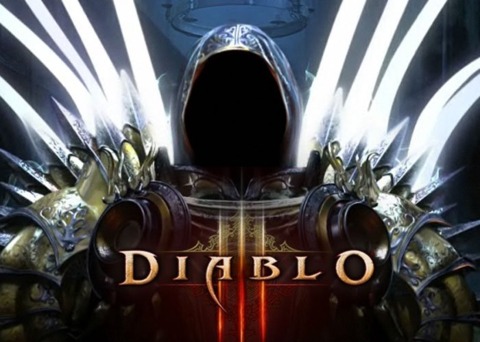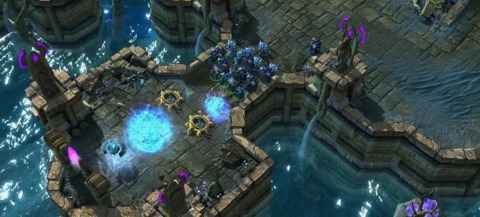Q&A: Looking back on launching Battle.net
Project director Greg Canessa reflects on the Real ID forum flare-up, why hardcore gamers are suspicious of social integration, and what's next for Blizzard's new cross-game platform.
At last week's Game Developers Conference Online, Blizzard's Battle.net project director Greg Canessa and technical director Matthew Versluys gave a postmortem on the still nascent online gaming service. The GDC Online keynote address offered perspective on the myriad logistical problems associated with launching the service, from tying together an existing community of 12 million World of Warcraft players, to launching worldwide on the same day as its showpiece game, the hotly anticipated Starcraft II. As if those tasks weren't difficult enough, the talk also delved into the problems Blizzard had staffing up the Battle.net team, as there aren't exactly a lot of applicants out there with experience doing those things.
Shortly afterward, Canessa sat down to answer some follow-up questions about the Real ID controversy, why gamers fear words like "Facebook" and "social features," and what's coming on the horizon for the online infrastructure that will power Starcraft II, Diablo III, and the rest of Blizzard's upcoming games for years to come.

GS: In your GDC Online session, you said the Real ID thing went over better than you expected. Was that in the context of its going over better than expected at launch, or during the time when the Blizzard forums were flooded with complaints?
GC: The statement in the presentation was about the initial reception when Rob Pardo and I announced it during our keynote at BlizzCon last year. What Matt was referring to was we were expecting if there was any backlash, it would have been when we announced the Real ID concept to the world last August. The following slide talked about some aspects being better received than others: the in-client social features, the Real ID inside Starcraft II, cross-game chat, friends lists, notifications. All the stuff we have in there has been super positively received overall by the community. Really the only exception to that was some of the stuff around the forums.
GS: And that was the requirement--that was eventually dropped--to use real names?
GC: That's right. And that was a totally separate thing. Though it used the same name, it was two completely different things. All the work we've been doing the past two years has been building out the client-side and server-side services to facilitate the friends invite, the toasts, notifications, and cross-game chat. That's the hard work, and that's why the forum thing was a footnote. That was a thing our Web team did. It was, "Oh yeah, we'll do it over here too." But that was not the focus.
So it was a little surprising, it was kind of a "wag the dog" situation. It was like, "What's that thing? That was like some little decision off to the side. Oh, that's a big deal? OK, we'll reverse it. People don't want it? Fine."

GS: So you didn't even have expectations for a response to that decision?
GC: We didn't expect it to be as vitriolic a response to the negative, it's fair to say. The level of heat [surprised us].
GS: So the features that you had anticipated to ruffle some feathers--like cross-game chat and the rest--seem like value-added features. Why were you worried about those rubbing users the wrong way?
GC: Well the cross-game chat, presence, and notifications, those were all not very controversial. The only thing we didn't know how it would be received was the whole concept behind Real ID, which is to introduce a layer of identity based on your real identity in the context of a gaming social network. That in and of itself is a hugely innovative thing but potentially a very controversial thing. People like Facebook, but that doesn't necessarily mean they're going to want Facebook in the context of a gaming service. So that was what surprised us to the positive, that it was so well received initially. And it's not just initially. People to this day still love the feature.
I think it was a driving force behind our decision--which ended up being the right decision--to maintain parallel levels of identity. That was the thing that was internally discussed quite a bit, and it was controversial in some parts. Hey, do we need these two levels of identity? Can we bring everything to the real identity level? Many of us felt that it was important to maintain that level of anonymity at that character ID level so that we respect that suspension of reality that so many gamers look to Blizzard games to enjoy.
GS: So why are gamers so suspicious when you say things like "social features" or "Facebook integration"?
GC: It's something we've definitely noticed more from the hardcore gaming community, and Blizzard has a lot of hardcore gamers. I'm not making a definitive statement on behalf of the industry, but I can tell you that Blizzard has observed there are some in our community that react viscerally in a very negative, emotional way to the social network phenomenon that's going on right now. Some have viewed it as "this Facebook thing my mom does," that it's for casual gamers because of the content that's on there, because their girlfriend uses, or whatever. I'm not exactly sure. I can only speculate and say there's a percentage of the audience that has reacted negatively to the feeling that social networks have overtaken everything.
So they were inherently skeptical when they heard there's some integration with Facebook, when in reality those same people have come back and apologized. They've said, "We're wrong. We shouldn't have doubted you. We misheard you or didn't read into it. We saw what you guys did and it's actually awesome. It saves us time, it doesn't have anything to do with pushing Facebook on my hardcore gamer buddies."
That was really a statement as to the complexity and communication challenges we have with some of these online gaming services combined with just getting the message out. It's resulted in some confusion as to what Blizzard's strategy is on some of these things until people actually see it in code.
GS: You guys obviously have a big hardcore base, but with 12 million people playing World of Warcraft, it clearly expands beyond just that. How do you expand that audience without alienating that hardcore base or making them feel left behind?

GC: It really comes down to Blizzard's core values and ideals: focusing on kickass entertainment experiences through the games and through the service. I wish there was a more complicated answer than that, but what the company does well is make awesome games. Our criteria is, "Is it cool, is it fun?" If it isn't, it gets cut. If it is, then as long as it doesn't hurt us in other ways that are against our other core values, then it stays in.
GS: How do you judge success of Battle.net when it's a product that exists strictly to enhance other products? Couldn't good or bad things be attributed to those other products?
GC: It comes back to our vision and our goal with Battle.net. That's to enhance the fun factor and entertainment value of each core Blizzard title by creating kickass online game experiences. So when we take a look at what we want to do with Diablo III or Starcraft II, we look at…how we come in as Battle.net and create an even more epic, cool, awesome multiplayer experience. We throw in a social network, achievements, and reward mechanisms, metagame features, community features, an awesome automated matchmaking system, a leagues and ladders competitive system. We create all this stuff around the game, allowing the Starcraft II team to stay focused on what they do best. We build that complementary skillset. I view it as additive, as complementary to the game teams.
GS: More specifically, do you just track how often the features you implemented are used?
GC: We definitely have a lot of tracking. We have a lot of data and understand the popularity of features that we roll into a beta. We definitely have a lot of data. But data is just that: It's a data point for us. Ultimately it comes down to what we think is cool. That's how Blizzard builds games. It's no different with Battle.net. We come up with a cool leagues and ladders system not because that's what data tells us that's what people want, but because we want to play in the leagues and ladder system.
GS: You've said you have a 10-year road map of features that you want to include in Battle.net. So how adaptable are you if you're heading in this direction and data or the players tell you they're not that crazy about that direction.
GC: Very adaptable, very malleable. We have a vision for what we want to do with Battle.net. We want to create this epic entertainment experience that will power all Blizzard games going forward, this connected community, that's pretty solid in terms of where we want to go overall. But in terms of specific features, there's a ton of flexibility. We weren't planning on necessarily doing chat channels or optimizations around search for custom maps as our first set of features, but we listened to customer feedback. We launched the game, there were forum posts and community posts, people saying, "This is very important to us." So we said, "You're right. We're gonna rejigger our road map and get this stuff out more quickly." I don't want to leave you with the impression that we're set in stone or that we're 100 percent malleable. The further out you go on that 10-year road map, the more malleable it is, but as you get closer to closer, we're willing to listen to feedback and will change if needed.
GS: What are some other features that are definitely going to happen sometime?
GC: Well another one is the marketplace. There's a lot of nuggets I didn't get time to talk about in my talk; one of them is the vibrancy of our mod and map community. Since launch, we have over 50,000 unique maps and mods on Battle.net published just in the United States, everything from puzzle games to first-person shooters to tower-defense games and everything in between. That's a huge opportunity for us. It's an ecosystem we've created around maps and mods and the custom game community that goes far beyond even our vision for Starcraft II and what we wanted to do with the core single-player and multiplayer game.
Marketplace is a huge set of features that will allow people to more easily find those maps, rate those maps, trade information on them, talk about them, have discussions around them, and download them for free or potentially sell them and give the map creator an opportunity to participate in the revenue.

GS: If the response is already so strong, how much concern is there that putting the exchange of money into the formula might temper or otherwise dampen the enthusiasm if it's not done properly?
GC: It's a great question, and that's why we're taking a similar approach to the marketplace as we did with the tiered approach we took with Real ID and character ID. We're not going to force anyone to charge anyone for anything. We're going to empower the map creation community to do what they want with their works. There will be a very vibrant, free offering as there is today, and we expect that won't change. But we're going to create an additional, optional tier to charge for their works if that's what they care to do.
GS: What do you see as Battle.net's competitors?
GC: We don't really have direct competitors in the traditional sense. I think there are other game services we draw inspiration from and are members of this small community of game services. We obviously know the guys at Valve very well and have a lot of respect for what they've done with Steam. They're a little more focused on digital distribution and less so on the metagame, community, and social features we're focused on. They're also more of a platform. We're kind of a hybrid platform and deeply integrated experience.
We also look at our friends at Xbox Live and the PlayStation Network as examples in the console space, but again they're more of a platform approach than a deeply integrated approach. We draw inspiration from some of the cool stuff going on in a smaller scale in the iPad-iPhone space--OpenFeint, Plus+, and now GameCenter--that are more at the indie and small-game level. There's Facebook in the social gaming space. But we really don't have anyone that's in our space in the way that we're doing this. It's kind of a hybridized, social-network-meets-game-platform-meets-deeply-integrated-approach specific to Blizzard games.
GS: So you don't have competitors so much as sources of inspiration?
GC: Yeah. I think we riff off of each other. There's stuff we're seeing in console games that is drawing inspiration off some stuff we're doing and vice versa. Same with social networks. It's a small club, a small group of people that are really enthusiastic about this space. But we're trying to grow it, and I really hope going forward we'll draw some attention to this corner of the games business. Not just from a headcount, hiring, and staffing standpoint, but also from an industry attention and relevance standpoint. [We want] more acknowledgement in the games industry as a whole that this is a rapidly growing and vibrant area of the space, this online game service space. It requires as much design and engineering acumen, as much iteration as building a game. It's an entertainment experience.
Why Are Video Game Adaptations Good Now? | Spot On Fallout 4 Next Gen Update Comparison Fallout 4 Steam Deck Verified Gameplay ALIEN: Rogue Incursion - Announcement Teaser Trailer Stellar Blade - 13 Things I Wish I Knew S.T.A.L.K.E.R. 2: Heart of Chornobyl — Official "Not a Paradise" Trailer Manor Lords - Official Medieval City Builder/RTS Launch Trailer Honkai: Star Rail - "Then Wake to Weep" | Version 2.2 Trailer Devil May Cry: Peak Of Combat | Dante: Blazing Tempest Gameplay Trailer SAND LAND — Official Launch Trailer Sea of Thieves Season 12: Official Content Update Video Stellar Blade - Hard Mode No Damage Gigas Boss Gameplay
Please enter your date of birth to view this video
By clicking 'enter', you agree to GameSpot's
Terms of Use and Privacy Policy
Got a news tip or want to contact us directly? Email news@gamespot.com
Join the conversation